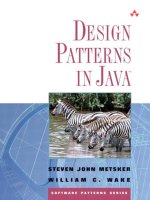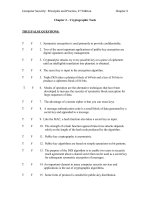Addison wesley concurrent programming in java design principles and patterns 2nd edition nov 1999 ISBN 0201310090
Bạn đang xem bản rút gọn của tài liệu. Xem và tải ngay bản đầy đủ của tài liệu tại đây (2.22 MB, 337 trang )
Chapter1.ConcurrentObject-Oriented
Programming
Thisbookdiscussessomewaysofthinkingabout,designing,and
implementingconcurrentprogramsintheJava™programming
language. Mostpresentationsinthisbookassumethatyouarean
experienceddeveloperfamiliarwithobject-oriented(OO)programming,
buthavelittleexposuretoconcurrency. Readerswiththeopposite
background—experiencewithconcurrencyinotherlanguages—may
alsofindthisbookuseful.
Thebookisorganizedintofourcoarse-grainedchapters.(Perhapsparts
wouldbeabetterterm.)Thisfirstchapterbeginswithabrieftourofsome
frequentlyusedconstructsandthenbacksuptoestablishaconceptual
basisforconcurrentobject-orientedprogramming:howconcurrencyand
objectsfittogether,howtheresultingdesignforcesimpactconstructionof
classesandcomponents,andhowsomecommondesignpatternscanbe
usedtostructuresolutions.
Thethreesubsequentchaptersarecenteredarounduse(andevasion)of
thethreekindsofconcurrencyconstructsfoundintheJavaprogramming
language:
Exclusion.Maintainingconsistentstatesofobjectsbypreventing
unwantedinterferenceamongconcurrentactivities,oftenusing
synchronizedmethods.
Statedependence.Triggering,preventing,postponing,orrecoveringfrom
actionsdependingonwhetherobjectsareinstatesinwhichtheseactions
couldordidsucceed,sometimesusingmonitormethodsObject.wait,
Object.notify,andObject.notifyAll.
Creatingthreads.Establishingandmanagingconcurrency,using
Threadobjects.
Eachchaptercontainsasequenceofmajorsections,eachonan
independenttopic.Theypresenthigh-leveldesignprinciplesand
strategies,technicaldetailssurroundingconstructs,utilitiesthat
encapsulatecommonusages,andassociateddesignpatternsthataddress
particularconcurrencyproblems.Mostsectionsconcludewithan
annotatedsetoffurtherreadingsprovidingmoreinformationonselected
topics.Theonlinesupplementtothisbookcontainslinkstoadditional
onlineresources,aswellasupdates,errata,andcodeexamples.Itis
accessiblevialinksfrom:
or />Ifyouarealreadyfamiliarwiththebasics,youcanreadthisbookinthe
presentedordertoexploreeachtopicinmoredepth.Butmostreaderswill
wanttoreadthisbookinvariousdifferentorders.Becausemost
concurrencyconceptsandtechniquesinteractwithmostothers,itisnot
alwayspossibletounderstandeachsectionorchapterincomplete
isolationfromalltheothers.However,youcanstilltakeabreadth-first
approach,brieflyscanningeachchapter(includingthisone)before
proceedingwithmoredetailedcoverageofinterest.Manypresentations
laterinthebookcanbeapproachedafterselectivelyreadingthrough
earliermaterialindicatedbyextensivecross-references.
Youcanpracticethisnowbyskimmingthroughthefollowingpreliminaries.
Terminology.ThisbookusesstandardOOterminologicalconventions:
programsdefinemethods(implementingoperations)andfields
(representingattributes)thatholdforallinstances(objects)ofspecified
classes.
InteractionsinOOprogramsnormallyrevolvearoundtheresponsibilities
placeduponaclientobjectneedinganactiontobeperformed,anda
serverobjectcontainingthecodetoperformtheaction.Thetermsclient
andserverareusedhereintheirgenericsenses,notinthespecialized
senseofdistributedclient/serverarchitectures.Aclientisjustanyobject
thatsendsarequesttoanotherobject,andaserverisjustanyobject
receivingsucharequest.Mostobjectsplaytherolesofbothclientsand
servers.Intheusualcasewhereitdoesn'tmatterwhetheranobjectunder
discussionactsasaclientorserverorboth,itisusuallycalledahost;
othersthatitmayinturninteractwithareoftencalledhelpersorpeers.
Also,whendiscussinginvocationsoftheformobj.msg(arg),the
recipient(thatis,theobjectboundtovariableobj)iscalledthetarget
object.
Thisbookgenerallyavoidsdealingwithtransientfactsaboutparticular
classesandpackagesnotdirectlyrelatedtoconcurrency.Anditdoesnot
coverdetailsaboutconcurrencycontrolinspecializedframeworkssuchas
EnterpriseJavaBeans™andServlets.Butitdoessometimesreferto
brandedsoftwareandtrademarkedproductsassociatedwiththeJava™
Platform. Thecopyrightpageofthisbookprovidesmoreinformation.
Codelistings.Mosttechniquesandpatternsinthisbookareillustratedby
variantsofanannoyinglysmallsetoftoyrunningexamples.Thisisnotan
efforttobeboring,buttobeclear.Concurrencyconstructsareoftensubtle
enoughtogetlostinotherwisemeaningfulexamples.Reuseofrunning
examplesmakessmallbutcriticaldifferencesmoreobviousbyhighlighting
themaindesignandimplementationissues.Also,thepresentations
includecodesketchesandfragmentsofclassesthatillustrate
implementationtechniques,butarenotintendedtobecompleteoreven
compilable.Theseclassesareindicatedbyleadingcommentsinthe
listings.
Importstatements,accessqualifiers,andevenmethodsandfieldsare
sometimesomittedfromlistingswhentheycanbeinferredfromcontextor
donotimpactrelevantfunctionality.Theprotectedqualifierisusedasa
defaultfornon-publicfeatureswheneverthereisnoparticularreasonto
restrictsubclassaccess.Thisemphasizesopportunitiesforextensibilityin
concurrentclassdesign(see§1.3.4and§3.3.3). Classesbydefault
havenoaccessqualifier.Samplelistingsaresometimesformattedin
nonstandardwaystokeepthemtogetheronpagesortoemphasizethe
mainconstructionsofinterest.
Thecodeforallexampleclassesinthisbookisavailablefromtheonline
supplement.Mosttechniquesandpatternsinthisbookareillustratedbya
singlecodeexampleshowingtheirmosttypicalforms.Thesupplement
includesadditionalexamplesthatdemonstrateminorvariations,aswellas
somelinkstootherknownusages.Italsoincludessomelargerexamples
thataremoreusefultobrowseandexperimentwithonlinethantoreadas
listings.
Thesupplementprovideslinkstoapackage,util.concurrent,that
containsproduction-qualityversionsofutilityclassesdiscussedinthis
book. ThiscoderunsontheJava2Platformandhasbeentestedwith
1.2.xreleases.Occasionaldiscussions,asides,andfootnotesbriefly
mentionchangesfrompreviousreleases,potentialfuturechangesknown
atthetimeofthiswriting,andafewimplementationquirkstowatchoutfor.
Checktheonlinesupplementforadditionalupdates.
Diagrams.StandardUMLnotationisusedforinteractionandclass
diagrams(seetheFurtherReadingsin§1.1.3).Theaccompanying
diagrams(courtesyofMartinFowler)illustratetheonlyformsusedinthis
book.OtheraspectsofUMLnotation,methodology,andterminologyare
notspecificallyreliedon.
Mostotherdiagramsshowtimethreadsinwhichfree-formgraycurves
tracethreadstraversingthroughcollectionsofobjects.Flattened
arrowheadsrepresentblocking.Objectsaredepictedasovalsthat
sometimesshowselectedinternalfeaturessuchaslocks,fields,andbitsof
code.Thin(usuallylabeled)linesbetweenobjectsrepresentrelations
(normallyreferencesorpotentialcalls)betweenthem.Here'sanotherwise
meaninglessexampleshowingthatthreadAhasacquiredthelockfor
objectX,andisproceedingthroughsomemethodinobjectYthatserves
asahelpertoX.ThreadBismeanwhilesomehowblockedwhileentering
somemethodinobjectX:
<aname="hit8">import
classParticle{</a>
src="1.1_files/nextmatch.gif"width="17"border="0"/></a>
protectedintx;
protectedinty;
protectedfinalRandomrng=newRandom();
publicParticle(intinitialX,intinitialY){
x=initialX;
y=initialY;
}
publicsynchronizedvoidmove(){
x+=rng.nextInt(10)-5;y+=rng.nextInt(20)-10;}
publicvoiddraw(Graphicsg){
intlx,ly;
synchronized(this){lx=x;ly=y;}
g.drawRect(lx,ly,10,10);}
}
classParticleCanvasextendsCanvas{
privateParticle[]particles=newParticle[0];
ParticleCanvas(intsize){
setSize(newDimension(size,size));}
//intendedtobecalledbyapplet
protectedsynchronizedvoidsetParticles(Particle[]ps){
if(ps==null)
thrownewIllegalArgumentException("Cannotsetnull");
particles=ps;
}
protectedsynchronizedParticle[]getParticles(){
returnparticles;
}
publicvoidpaint(Graphicsg){//overrideCanvas.paintParticle[]ps
=getParticles();
for(inti=0;i
}
<aname="hit12">publicinterface
href=" />height="11"src="1.1_files/nextmatch.gif"width="17"border="0"/>
</a>voidrun();
}
publicclassParticleAppletextendsApplet{
protectedThread[]threads=null;//nullwhennotrunning
protectedfinalParticleCanvascanvas
=newParticleCanvas(100);
publicvoidinit(){add(canvas);}
protectedThreadmakeThread(finalParticlep){//utilityRunnable
runloop=newRunnable(){
publicvoidrun(){
try{
for(;;){
p.move();
canvas.repaint();
Thread.sleep(100);//100msecisarbitrary}
}
catch(InterruptedExceptione){return;}
}
};
returnnewThread(runloop);}
publicsynchronizedvoidstart(){
intn=10;//justfordemo
if(threads==null){//bypassifalreadystartedParticle[]particles
=newParticle[n];for(inti=0;i
threads=newThread[n];for(inti=0;i
}
}
publicsynchronizedvoidstop(){
if(threads!=null){//bypassifalreadystoppedfor(inti=0;i<
threads.length;++i)threads[i].interrupt();threads=null;
}
}
}
if(Math.random()<0.01)Thread.yield();
OnJVMimplementationsthatemploypre-emptivescheduling
policies,especiallythoseonmultiprocessors,itispossibleandeven
desirablethattheschedulerwillsimplyignorethishintprovidedby
yield.
1.1.2.6ThreadGroups
EveryThreadisconstructedasamemberofaThreadGroup,bydefault
thesamegroupasthatoftheThreadissuingtheconstructorforit.
ThreadGroupsnestinatree-likefashion.Whenanobjectconstructsa
newThreadGroup,itisnestedunderitscurrentgroup.Themethod
getThreadGroupreturnsthegroupofanythread.TheThreadGroup
classinturnsupportsmethodssuchasenumeratethatindicatewhich
threadsarecurrentlyinthegroup.
OnepurposeofclassThreadGroupistosupportsecuritypoliciesthat
dynamicallyrestrictaccesstoThreadoperations;forexample,to
makeitillegaltointerruptathreadthatisnotinyourgroup.Thisis
onepartofasetofprotectivemeasuresagainstproblemsthatcould
occur,forexample,ifanappletweretotrytokillthemainscreen
displayupdatethread.ThreadGroupsmayalsoplaceaceilingonthe
maximumprioritythatanymemberthreadcanpossess.
ThreadGroupstendnottobeuseddirectlyinthread-basedprograms.
Inmostapplications,normalcollectionclasses(forexample
java.util.Vector)arebetterchoicesfortrackinggroupsofThread
objectsforapplication-dependentpurposes.
AmongthefewThreadGroupmethodsthatcommonlycomeintoplay
inconcurrentprogramsismethoduncaughtException,whichis
invokedwhenathreadinagroupterminatesduetoanuncaught
uncheckedexception(forexampleaNullPointerException).This
methodnormallycausesastacktracetobeprinted.
1.1.3FurtherReadings
ThisbookisnotareferencemanualontheJavaprogramming
language.(Itisalsonotexclusivelyahow-totutorialguide,oran
academictextbookonconcurrency,orareportonexperimental
research,orabookondesignmethodologyordesignpatternsor
patternlanguages,butincludesdiscussionsoneachofthesefacetsof
concurrency.)Mostsectionsconcludewithlistsofresourcesthat
providemoreinformationonselectedtopics.Ifyoudoalotof
concurrentprogramming,youwillwanttoreadmoreaboutsomeof
them.
TheJLSshouldbeconsultedformoreauthoritativeaccountsofthe
propertiesofJavaprogramminglanguageconstructssummarizedin
thisbook:
Gosling,James,BillJoy,andGuySteele.TheJava™Language
Specification,Addison-Wesley,1996.Asofthiswriting,asecond
editionofJLSisprojectedtocontainclarificationsandupdatesforthe
Java2Platform.
Introductoryaccountsinclude:Arnold,Ken,andJamesGosling.The
Java™ProgrammingLanguage,SecondEdition,Addison-Wesley,
1998.
Ifyouhaveneverwrittenaprogramusingthreads,youmayfindit
usefultoworkthrougheithertheonlineorbookversionofthe
Threadssectionof:
Campione,Mary,andKathyWalrath.TheJava™Tutorial,Second
Edition,Addison-Wesley,1998.
AconciseguidetoUMLnotationis:Fowler,Martin,withKendall
Scott.UMLDistilled,SecondEdition,Addison-Wesley,1999.The
UMLdiagramkeysonpages3-4ofthepresentbookareexcerptedby
permission.
AmoreextensiveaccountofUMLis:Rumbaugh,James,Ivar
Jacobson,andGradyBooch.TheUnifiedModelingLanguage
ReferenceManual,Addison-Wesley,1999.
1.2ObjectsandConcurrency
Therearemanywaystocharacterizeobjects,concurrency,andtheirrelationships.
sectiondiscussesseveraldifferentperspectives—definitional,system-based,stylistic,
andmodeling-based—thattogetherhelpestablishaconceptualbasisforconcurrent
object-orientedprogramming.
1.2.1Concurrency
Likemostcomputingterms,"concurrency"istrickytopindown.Informally,a
concurrentprogramisonethatdoesmorethanonethingatatime. Forexample,a
webbrowsermaybesimultaneouslyperforminganHTTPGETrequesttogetanHTML
page,playinganaudioclip,displayingthenumberofbytesreceivedofsomeimage,
andengaginginanadvisorydialogwithauser.However,thissimultaneityis
sometimesanillusion.Onsomecomputersystemsthesedifferentactivitiesmight
indeedbeperformedbydifferentCPUs.Butonothersystemstheyareallperformed
asingletime-sharedCPUthatswitchesamongdifferentactivitiesquicklyenoughthat
theyappeartobesimultaneous,oratleastnondeterministicallyinterleaved,tohuman
observers.
Amoreprecise,thoughnotveryinterestingdefinitionofconcurrentprogramming
bephrasedoperationally: AJavavirtualmachineanditsunderlyingoperatingsystem
(OS)providemappingsfromapparentsimultaneitytophysicalparallelism(viamultiple
CPUs),orlackthereof,byallowingindependentactivitiestoproceedinparallelwhen
possibleanddesirable,andotherwisebytime-sharing. Concurrentprogramming
consistsofusingprogrammingconstructsthataremappedinthisway. Concurrent
programmingintheJavaprogramminglanguageentailsusingJavaprogramming
languageconstructstothiseffect,asopposedtosystem-levelconstructsthatareused
tocreatenewoperatingsystemprocesses. Byconvention,thisnotionisfurther
restrictedtoconstructsaffectingasingleJVM,asopposedtodistributed
programming,forexampleusingremotemethodinvocation(RMI),thatinvolves
multipleJVMsresidingonmultiplecomputersystems.
Concurrencyandthereasonsforemployingitarebettercapturedbyconsideringthe
natureofafewcommontypesofconcurrentapplications:
Webservices.Mostsocket-basedwebservices(forexample,HTTPdaemons,servlet
engines,andapplicationservers)aremultithreaded.Usually,themainmotivationfor
supportingmultipleconcurrentconnectionsistoensurethatnewincoming
connectionsdonotneedtowaitoutcompletionofothers. Thisgenerallyminimizes
servicelatenciesandimprovesavailability.
Numbercrunching.Manycomputation-intensivetaskscanbeparallelized,andthus
executemorequicklyifmultipleCPUsarepresent.Herethegoalistomaximize
throughputbyexploitingparallelism.
I/Oprocessing.Evenonanominallysequentialcomputer,devicesthatperformreads
andwritesondisks,wires,etc.,operateindependentlyoftheCPU.Concurrent
programscanusethetimeotherwisewastedwaitingforslowI/O,andcanthusmake
moreefficientuseofacomputer'sresources.
Simulation.Concurrentprogramscansimulatephysicalobjectswithindependent
autonomousbehaviorsthatarehardtocaptureinpurelysequentialprograms.
GUI-basedapplications.Eventhoughmostuserinterfacesareintentionallysinglethreaded,theyoftenestablishorcommunicatewithmultithreadedservices.
Concurrencyenablesusercontrolstostayresponsiveevenduringtime-consuming
actions.
Component-basedsoftware.Large-granularitysoftwarecomponents(forexample
thoseprovidingdesigntoolssuchaslayouteditors)mayinternallyconstructthreadsin
ordertoassistinbookkeeping,providemultimediasupport,achievegreaterautonomy,
orimproveperformance.
Mobilecode.Frameworkssuchasthejava.appletpackageexecutedownloaded
codeinseparatethreadsasonepartofasetofpoliciesthathelptoisolate,monitor,
andcontroltheeffectsofunknowncode.
Embeddedsystems.Mostprogramsrunningonsmalldedicateddevicesperformrealtimecontrol.Multiplecomponentseachcontinuouslyreacttoexternalinputsfrom
sensorsorotherdevices,andproduceexternaloutputsinatimelymanner.Asdefined
inTheJava™LanguageSpecification,theJavaplatformdoesnotsupporthardrealtimecontrolinwhichsystemcorrectnessdependsonactionsbeingperformedby
certaindeadlines. Particularrun-timesystemsmayprovidethestrongerguarantees
requiredinsomesafety-criticalhard-real-timesystems.ButallJVMimplementations
supportsoftreal-timecontrol,inwhichtimelinessandperformanceareconsidered
quality-of-serviceissuesratherthancorrectnessissues(see§1.3.3).Thisreflects
portabilitygoalsthatenabletheJVMtobeimplementedonmodernopportunistic,
multipurposehardwareandsystemsoftware.
1.2.2ConcurrentExecutionConstructs
Threadsareonlyoneofseveralconstructsavailableforconcurrentlyexecutingcode.
Theideaofgeneratinganewactivitycanbemappedtoanyofseveralabstractions
alongagranularitycontinuumreflectingtrade-offsofautonomyversusoverhead.
Thread-baseddesignsdonotalwaysprovidethebestsolutiontoagivenconcurrency
problem.Selectionofoneofthealternativesdiscussedbelowcanprovideeithermore
orlesssecurity,protection,fault-tolerance,andadministrativecontrol,witheithermore
orlessassociatedoverhead.Differencesamongtheseoptions(andtheirassociated
programmingsupportconstructs)impactdesignstrategiesmorethandoanyofthe
detailssurroundingeachone.
1.2.2.1Computersystems
Ifyouhadalargesupplyofcomputersystems,youmightmapeachlogicalunitof
executiontoadifferentcomputer.Eachcomputersystemmaybeauniprocessor,a
multiprocessor,orevenaclusterofmachinesadministeredasasingleunitandsharing
acommonoperatingsystem.Thisprovidesunboundedautonomyandindependence.
Eachsystemcanbeadministeredandcontrolledseparatelyfromalltheothers.
However,constructing,locating,reclaiming,andpassingmessagesamongsuch
entitiescanbeexpensive,opportunitiesforsharinglocalresourcesareeliminated,and
solutionstoproblemssurroundingnaming,security,fault-tolerance,recovery,and
reachabilityareallrelativelyheavyincomparisonwiththoseseeninconcurrent
programs. Sothismappingchoiceistypicallyappliedonlyforthoseaspectsofa
systemthatintrinsicallyrequireadistributedsolution.Andevenhere,allbutthetiniest
embeddedcomputerdeviceshostmorethanoneprocess.
1.2.2.2Processes
Aprocessisanoperating-systemabstractionthatallowsonecomputersystemto
supportmanyunitsofexecution.Eachprocesstypicallyrepresentsaseparaterunning
program;forexample,anexecutingJVM.Likethenotionofa"computersystem",a
"process"isalogicalabstraction,notaphysicalone.So,forexample,bindingsfrom
processestoCPUsmayvarydynamically.
Operatingsystemsguaranteesomedegreeofindependence,lackofinterference,and
securityamongconcurrentlyexecutingprocesses.Processesaregenerallynotallowed
toaccessoneanother'sstoragelocations(althoughthereareusuallysome
exceptions),andmustinsteadcommunicateviainterprocesscommunicationfacilities
suchaspipes.Mostsystemsmakeatleastbest-effortpromisesabouthowprocesses
willbecreatedandscheduled.Thisnearlyalwaysentailspre-emptivetime-slicing—
suspendingprocessesonaperiodicbasistogiveotherprocessesachancetorun.
Theoverheadforcreating,managing,andcommunicatingamongprocessescanbea
lotlowerthaninper-machinesolutions.However,sinceprocessesshareunderlying
computationalresources(CPUs,memory,IOchannels,andsoon),theyareless
autonomous.Forexample,amachinecrashcausedbyoneprocesskillsallprocesses.
1.2.2.3Threads
Threadconstructsofvariousformsmakefurthertrade-offsinautonomy,inpartforthe
sakeofloweroverhead.Themaintrade-offsare:
Sharing.Threadsmayshareaccesstothememory,openfiles,andotherresources
associatedwithasingleprocess.ThreadsintheJavaprogramminglanguagemay
shareallsuchresources. Someoperatingsystemsalsosupportintermediate
constructions,forexample"lightweightprocesses"and"kernelthreads"thatshareonly
someresources,dosoonlyuponexplicitrequest,orimposeotherrestrictions.
Scheduling.Independenceguaranteesmaybeweakenedtosupportcheaper
schedulingpolicies.Atoneextreme,allthreadscanbetreatedtogetherasasinglethreadedprocess,inwhichcasetheymaycooperativelycontendwitheachother
thatonlyonethreadisrunningatatime,withoutgivinganyotherthreadachanceto
rununtilitblocks(see§1.3.2).Attheotherextreme,theunderlyingschedulercan
allowallthreadsinasystemtocontenddirectlywitheachotherviapre-emptive
schedulingrules.ThreadsintheJavaprogramminglanguagemaybescheduled
usinganypolicylyingatoranywherebetweentheseextremes.
Communication.Systemsinteractviacommunicationacrosswiresorwireless
channels,forexampleusingsockets. Processesmayalsocommunicateinthis
fashion,butmayalsouselightermechanismssuchaspipesandinterprocess
signallingfacilities.Threadscanusealloftheseoptions,plusothercheaperstrategies
relyingonaccesstomemorylocationsaccessibleacrossmultiplethreads,and
employingmemory-basedsynchronizationfacilitiessuchaslocksandwaitingand
notificationmechanisms.Theseconstructssupportmoreefficientcommunication,but
sometimesincurtheexpenseofgreatercomplexityandconsequentlygreaterpotential
forprogrammingerror.
1.2.2.4Tasksandlightweightexecutableframeworks
Thetrade-offsmadeinsupportingthreadscoverawiderangeofapplications,butare
notalwaysperfectlymatchedtotheneedsofagivenactivity.Whileperformancedetails
differacrossplatforms,theoverheadincreatingathreadisstillsignificantlygreater
thanthecheapest(butleastindependent)waytoinvokeablockofcode—callingit
directlyinthecurrentthread.
Whenthreadcreationandmanagementoverheadbecomeperformanceconcerns,you
maybeabletomakeadditionaltrade-offsinautonomybycreatingyourownlighterweightexecutionframeworksthatimposefurtherrestrictionsonusage(forexampleby
forbiddinguseofcertainformsofblocking),ormakefewerschedulingguarantees,or
restrictsynchronizationandcommunicationtoamorelimitedsetofchoices.As
discussedin§4.1.4,thesetaskscanthenbemappedtothreadsinaboutthesame
waythatthreadsaremappedtoprocessesandcomputersystems.
Themostfamiliarlightweightexecutableframeworksareevent-basedsystemsand
subsystems(see§1.2.3,§3.6.4,and§4.1),inwhichcallstriggeringconceptually
asynchronousactivitiesaremaintainedaseventsthatmaybequeuedandprocessed
bybackgroundthreads.Severaladditionallightweightexecutableframeworksare
describedinChapter4.Whentheyapply,constructionanduseofsuchframeworkscan
improveboththestructureandperformanceofconcurrentprograms. Theiruse
reducesconcerns(see§1.3.3)thatcanotherwiseinhibittheuseofconcurrent
executiontechniquesforexpressinglogicallyasynchronousactivitiesandlogically
autonomousobjects(see§1.2.4).
1.2.3ConcurrencyandOOProgramming
Objectsandconcurrencyhavebeenlinkedsincetheearliestdaysofeach.Thefirst
concurrentOOprogramminglanguage(createdcirca1966),Simula,wasalso
firstOOlanguage,andwasamongthefirstconcurrentlanguages. Simula'sinitial
OOandconcurrencyconstructsweresomewhatprimitiveandawkward.Forexample,
concurrencywasbasedaroundcoroutines—thread-likeconstructsrequiringthat
programmersexplicitlyhandoffcontrolfromonetasktoanother.Severalother
languagesprovidingbothconcurrencyandOOconstructsfollowed—indeed,even
someoftheearliestprototypeversionsofC++includedafewconcurrency-support
libraryclasses.AndAda(although,initsfirstversions,scarcelyanOOlanguage)
helpedbringconcurrentprogrammingoutfromtheworldofspecialized,low-level
languagesandsystems.
OOdesignplayednopracticalroleinthemultithreadedsystemsprogramming
practicesemerginginthe1970s. Andconcurrencyplayednopracticalroleinthe
wide-scaleembraceofOOprogrammingthatbeganinthe1980s. Butinterestin
OOconcurrencystayedaliveinresearchlaboratoriesandadvanceddevelopment
groups,andhasre-emergedasanessentialaspectofprogramminginpartduetothe
popularityandubiquityoftheJavaplatform.
ConcurrentOOprogrammingsharesmostfeatureswithprogrammingofanykind.
Butitdiffersincriticalwaysfromthekindsofprogrammingyoumaybemostfamiliar
with,asdiscussedbelow.
1.2.3.1SequentialOOprogramming
ConcurrentOOprogramsareoftenstructuredusingthesameprogramming
techniquesanddesignpatternsassequentialOOprograms(seeforexample§1.4
Buttheyareintrinsicallymorecomplex.Whenmorethanoneactivitycanoccurata
time,programexecutionisnecessarilynondeterministic.Codemayexecutein
surprisingorders—anyorderthatisnotexplicitlyruledoutisallowed(see§2.2.7
youcannotalwaysunderstandconcurrentprogramsbysequentiallyreadingthrough
theircode. Forexample,withoutfurtherprecautions,afieldsettoonevalueinone
lineofcodemayhaveadifferentvalue(duetotheactionsofsomeotherconcurrent
activity)bythetimethenextlineofcodeisexecuted. Dealingwiththisandother
formsofinterferenceoftenintroducestheneedforabitmorerigorandamore
conservativeoutlookondesign.
1.2.3.2Event-basedprogramming
Someconcurrentprogrammingtechniqueshavemuchincommonwiththosein
eventframeworksemployedinGUItoolkitssupportedbyjava.awtand
javax.swing,andinotherlanguagessuchasTcl/TkandVisualBasic. InGUI
frameworks,eventssuchasmouseclicksareencapsulatedasEventobjectsthatare
placedinasingleEventQueue.Theseeventsarethendispatchedandprocessed
one-by-oneinasingleeventloop,whichnormallyrunsasaseparatethread.As
discussedin§4.1,thisdesigncanbeextendedtosupportadditionalconcurrencyby
(amongothertactics)creatingmultipleeventloopthreads,eachconcurrently
processingevents,orevendispatchingeacheventinaseparatethread.Again,this
opensupnewdesignpossibilities,butalsointroducesnewconcernsaboutinterference
andcoordinationamongconcurrentactivities.
1.2.3.3Concurrentsystemsprogramming
Object-orientedconcurrentprogrammingdiffersfrommultithreadedsystems
programminginlanguagessuchasCmainlyduetotheencapsulation,modularity,
extensibility,security,andsafetyfeaturesotherwiselackinginC.Additionally,
concurrencysupportisbuiltintotheJavaprogramminglanguage,ratherthan
suppliedbylibraries. Thiseliminatesthepossibilityofsomecommonerrors,and
enablescompilerstoautomaticallyandsafelyperformsomeoptimizationsthatwould
needtobeperformedmanuallyinC.
WhileconcurrencysupportconstructsintheJavaprogramminglanguageare
generallysimilartothoseinthestandardPOSIXpthreadslibraryandrelatedpackages
typicallyusedinC,therearesomeimportantdifferences,especiallyinthedetailsof
waitingandnotification(see§3.2.2). Itisverypossibletouseutilityclassesthatact
almostjustlikePOSIXroutines(see§3.4.4).Butitisoftenmoreproductiveinsteadto
makeminoradjustmentstoexploittheversionsthatthelanguagedirectlysupports.
1.2.3.4Otherconcurrentprogramminglanguages
Essentiallyallconcurrentprogramminglanguagesare,atsomelevel,equivalent,if
onlyinthesensethatallconcurrentlanguagesarewidelybelievednottohavedefined
therightconcurrencyfeatures. However,itisnotallthathardtomakeprogramsin
onelanguagelookalmostequivalenttothoseinotherlanguagesorthoseusingother
constructs,bydevelopingpackages,classes,utilities,tools,andcodingconventions
thatmimicfeaturesbuiltintoothers. Inthecourseofthisbook,constructionsare
introducedthatprovidethecapabilitiesandprogrammingstylesofsemaphore-based
systems(§3.4.1),futures(§4.3.3),barrier-basedparallelism(§4.4.3),CSP(§4.5.1
andothers. Itisaperfectlygreatideatowriteprogramsusingonlyoneofthese
styles,ifthissuitsyourneeds. However,manyconcurrentdesigns,patterns,
frameworks,andsystemshaveeclecticheritagesandstealgoodideasfromanywhere
theycan.
1.2.4ObjectModelsandMappings
ConceptionsofobjectsoftendifferacrosssequentialversusconcurrentOO
programming,andevenacrossdifferentstylesofconcurrentOOprogramming
Contemplationoftheunderlyingobjectmodelsandmappingscanrevealthenatureof
differencesamongprogrammingstyleshintedatintheprevioussection.
Mostpeopleliketothinkofsoftwareobjectsasmodelsofrealobjects,representedwith
somearbitrarydegreeofprecision.Thenotionof"real"isofcourseintheeyeofthe
beholder,andoftenincludesartificesthatmakesenseonlywithintherealmof
computation.
Forasimpleexample,considertheskeletalUMLclassdiagramandcodesketchfor
classWaterTank:
classWaterTank{//Codesketch
finalfloatcapacity;
floatcurrentVolume=0.0f;
WaterTankoverflow;
WaterTank(floatcap){capacity=cap;...}
voidaddWater(floatamount)throwsOverflowException;
voidremoveWater(floatamount)throwsUnderflowException;
}
Theintenthereistorepresent,orsimulate,awatertankwith:
AttributessuchascapacityandcurrentVolume,thatarerepresentedas
fieldsofWaterTankobjects.Wecanchooseonlythoseattributesthatwe
happentocareaboutinsomesetofusagecontexts.Forexample,whileallreal
watertankshavelocations,shapes,colors,andsoon,thisclassonlydeals
volumes.
Invariantstateconstraints,suchasthefactsthatthecurrentVolumealways
remainsbetweenzeroandcapacity,andthatcapacityisnonnegative
neverchangesafterconstruction.
OperationsdescribingbehaviorssuchasthosetoaddWaterand
removeWater.Thischoiceofoperationsagainreflectssomeimplicitdesign
decisionsconcerningaccuracy,granularityandprecision.Forexample,wecould
havechosentomodelwatertanksatthelevelofvalvesandswitches,andcould
havemodeledeachwatermoleculeasanobjectthatchangeslocationasthe
resultoftheassociatedoperations.
Connections(andpotentialconnections)tootherobjectswithwhichobjects
communicate,suchaspipesorothertanks.Forexample,excesswater
encounteredinanaddWateroperationcouldbeshuntedtoanoverflowtank
thatisknownbyeachtank.
Preconditionsandpostconditionsontheeffectsofoperations,suchasrules
statingthatitisimpossibletoremovewaterfromanemptytank,ortoaddwaterto
afulltankthatisnotequippedwithanavailableoverflowtank.
Protocolsconstrainingwhenandhowmessages(operationrequests)are
processed.Forexample,wemayimposearulethatatmostoneaddWater
removeWatermessageisprocessedatanygiventimeor,alternatively,arule
statingthatremoveWatermessagesareallowedinthemidstofaddWater
operations.
1.2.4.1Objectmodels
TheWaterTankclassusesobjectstomodelreality.Objectmodelsproviderulesand
frameworksfordefiningobjectsmoregenerally,covering:
Statics.Thestructureofeachobjectisdescribed(normallyviaaclass)intermsof
internalattributes(state),connectionstootherobjects,local(internal)methods,and
methodsorportsforacceptingmessagesfromotherobjects.
Encapsulation.Objectshavemembranesseparatingtheirinsidesandoutsides.
Internalstatecanbedirectlymodifiedonlybytheobjectitself.(Weignorefornow
languagefeaturesthatallowthisruletobebroken.)
Communication.Objectscommunicateonlyviamessagepassing.Objectsissue
messagesthattriggeractionsinotherobjects.Theformsofthesemessagesmay
rangefromsimpleproceduralcallstothosetransportedviaarbitrarycommunication
protocols.
Identity.Newobjectscanbeconstructedatanytime(subjecttosystemresource
constraints)byanyobject(subjecttoaccesscontrol).Onceconstructed,eachobject
maintainsauniqueidentitythatpersistsoveritslifetime.
Connections.Oneobjectcansendmessagestoothersifitknowstheiridentities.
Somemodelsrelyonchannelidentitiesratherthanorinadditiontoobjectidentities.
Abstractly,achannelisavehicleforpassingmessages.Twoobjectsthatsharea
channelmaypassmessagesthroughthatchannelwithoutknowingeachother's
identities.TypicalOOmodelsandlanguagesrelyonobject-basedprimitivesfordirect
methodinvocations,channel-basedabstractionsforIOandcommunicationacross
wires,andconstructionssuchaseventchannelsthatmaybeviewedfromeither
perspective.
Computation.Objectsmayperformfourbasickindsofcomputation:
Acceptamessage.
Updateinternalstate.
Sendamessage.
Createanewobject.
Thisabstractcharacterizationcanbeinterpretedandrefinedinseveralways.For
example,onewaytoimplementaWaterTankobjectistobuildatinyspecial-purpose
hardwaredevicethatonlymaintainstheindicatedstates,instructions,andconnections.
Butsincethisisnotabookonhardwaredesign,we'llignoresuchoptionsandrestrict
attentiontosoftware-basedalternatives.
1.2.4.2Sequentialmappings
Thefeaturesofanordinarygeneral-purposecomputer(aCPU,abus,somememory,
andsomeIOports)canbeexploitedsothatthiscomputercanpretenditisanyobject,
forexampleaWaterTank.Thiscanbearrangedbyloadingadescriptionof
WaterTanks(viaa.classfile)intoaJVM.TheJVMcanthenconstructapassive
representationofaninstanceandtheninterprettheassociatedoperations.This
mappingstrategyalsoappliesattheleveloftheCPUwhenoperationsarecompiled
intonativecoderatherthaninterpretedasbytecodes.Italsoextendstoprograms
involvingmanyobjectsofdifferentclasses,eachloadedandinstantiatedasneeded,by
havingtheJVMatalltimesrecordtheidentity("this")oftheobjectitiscurrently
simulating.
Inotherwords,theJVMisitselfanobject,althoughaveryspecialonethatcanpretend
itisanyotherobject.(Moreformally,itservesasaUniversalTuringMachine.)While
similarremarksholdforthemappingsusedinmostotherlanguages,Classobjects
andreflectionmakeitsimplertocharacterizereflectiveobjectsthattreatotherobjects
asdata.
Inapurelysequentialenvironment,thisistheendofthestory.Butbeforemovingon,
considertherestrictionsonthegenericobjectmodelimposedbythismapping.Ona
sequentialJVM,itwouldbeimpossibletodirectlysimulatemultipleconcurrent
interactingwaterTankobjects. Andbecauseallmessage-passingisperformedvia
sequentialproceduralinvocation,thereisnoneedforrulesaboutwhethermultiple
messagesmaybeprocessedconcurrently—theyneverareanyway.Thus,sequential
OOprocessinglimitsthekindsofhigh-leveldesignconcernsyouareallowedto
express.
1.2.4.3Activeobjects
Attheotherendofthemappingspectrumareactiveobjectmodels(alsoknownas
actormodels),inwhicheveryobjectisautonomous.Eachmaybeaspowerfulasa
sequentialJVM.Internalclassandobjectrepresentationsmaytakethesameformsas
thoseusedinpassiveframeworks.Forexamplehere,eachwaterTankcouldbe
mappedtoaseparateactiveobjectbyloadinginadescriptiontoaseparateJVM,and
thenforeverallowingittosimulatethedefinedactions.
Activeobjectmodelsformacommonhigh-levelviewofobjectsindistributedobjectorientedsystems:Differentobjectsmayresideondifferentmachines,sothelocation
andadministrativedomainofanobjectareoftenimportantprogrammingissues.
messagepassingisarrangedviaremotecommunication(forexampleviasockets)that
mayobeyanyofanumberofprotocols,includingonewaymessaging(i.e.,messages
thatdonotintrinsicallyrequirereplies),multicasts(simultaneouslysendingthesame
messagetomultiplerecipients),andprocedure-stylerequest-replyexchanges.
Thismodelalsoservesasanobject-orientedviewofmostoperating-system-level
processes,eachofwhichisasindependentof,andsharesasfewresourceswith,other
processesaspossible(see§1.2.2).
1.2.4.4Mixedmodels









